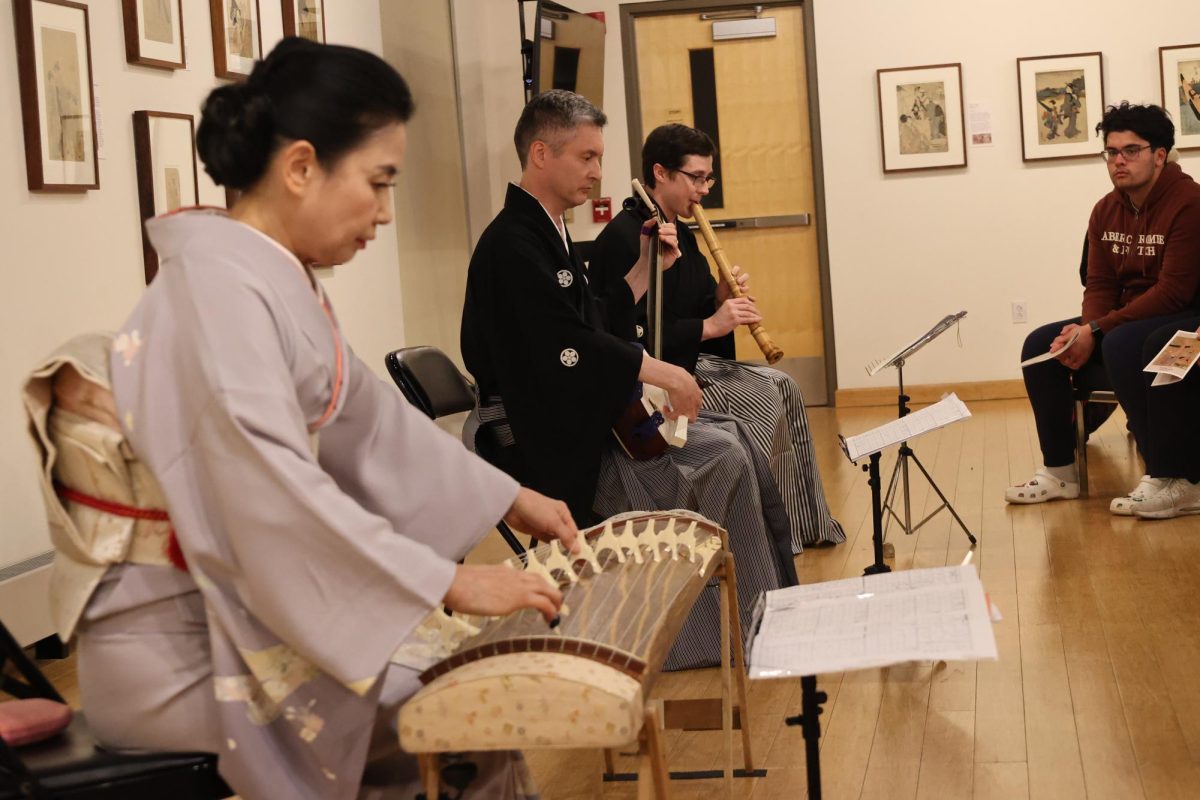The Misericordia University Pauly Friedman Art Gallery has displayed a unique set of traditional Japanese artwork and clothing through January and March. As a special incorporation, Dr. Little, director of the gallery, hosted an event dedicated to celebrating traditional Japanese instruments. Doors were open free to students, faculty, and those of the public to enjoy some light refreshments following a grandiose show.
On the evening of Thursday, February 15, 2024, Masayo Ishigure and two guest musicians, Kenneth Hutchinson and Travis Shaver, welcomed an overflowing crowd of students, faculty, and general members of the public to showcase various compositions played on three different Japanese instruments.
Masayo Ishigure learned to play the koto, a large stringed instrument with a wooden soundboard, at just five years old. She has been performing and teaching professionally in the United States for more than 35 years. Alongside Ishigure was Kenneth Hutchinson, playing the shamisen – an instrument similar to the banjo – and Travis Shaver playing the shakuhachi – an instrument similar to the flute and recorder. Within about two hours, the three musicians presented an array of Japanese pieces with a mix of both contemporary and traditional genres.
Following the performance, The Highlander was able to discuss with those in attendance and get their take on the show.
One family consisting of a mother and her two children valued the koto and company performance. As someone of Chinese descent, the mother found similarities in her own culture and loved sharing it with her children. She mentioned that both play their own instruments, so it was something familiar and enjoyable for her family.
Other audience members didn’t know what to expect. One woman shared that her son resides in Japan, so of course she had an understanding of some traditional instruments; however, as the performance continued, she found herself becoming more acquainted with the koto and company. The historical context of both the instruments and music was a great touch to the performance, and overall she found it quite delightful.
First-year students, Ava Rocky and Victoria Galicki gushed about how captivating the performance was.
“Afterwards, I felt very fulfilled and whole. It was something I’ve never experienced before,” said Galicki. She was just as excited as any other attendee, but for her, it ended in the cleansing of her soul. The event defied her expectations. “It was truly an honor,” Galicki said.
Rocky offered her take on the range of instruments, “I was very surprised at how well every instrument worked with one another.” The improvisational section seemed to be her favorite, leaving her awestruck and impressed. “Each instrument seemed to embellish the following one. There was a moment to highlight each sound,” described Rocky.
For all of those in attendance, the event filled people with a sort of air afterward. Those who may have entered with a burden or stress left feeling lighter and ready to take on the next task. It continues the truth of music holding healing properties and allows for a sense of community when all can experience it together.
When taking the time with the Koto performer herself, Masayo Ishigure expressed her meaning of the Koto. “I don’t really know if I can say I have one because I’m still playing,” she confessed.
Growing up learning the traditional Japanese instrument, Ishigure had a very individual and somewhat isolated experience. “It was me and then my teacher. None of my friends around me were playing the koto,” she said.
Of course, she was just like any other teenager. She found herself enjoying Japanese pop and various other genres rather than consuming only classical pieces of music. It wasn’t until Ishigure was thirteen that she fully admitted that Koto was what she wanted to continue doing for the rest of her life.
It was an honor for Misericordia University and all in attendance to experience the beauty of the koto, shamisen, and shakuhachi. Embracing a plethora of cultures and harnessing the meaning of diversity is the very root of the institution, so events like this one work well to enhance the campus and those around it.
Let the performance be a gateway to a new mindset and a clean, fresh start. The Pauly Friedman Art Gallery will host the “Floating Beauty,” display until Sunday, March 10, 2024. Be sure to stop by and experience the traditional art of Japanese culture along with the lingering sound of a wonderful performance.

